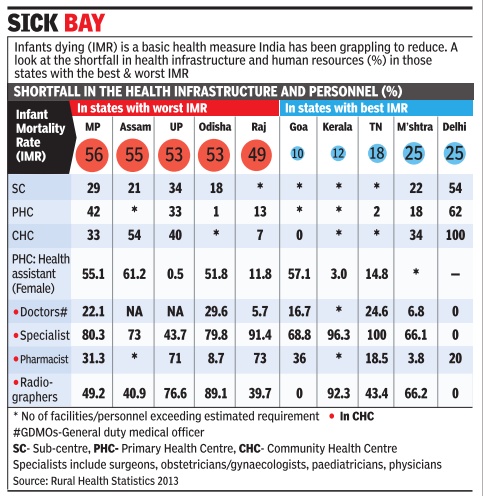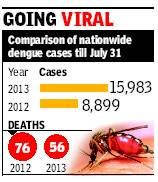Healthcare: India
(→Better healthcare still out of bounds) |
|||
| Line 112: | Line 112: | ||
What highlights all of this as a glaring failure of our governments is the fact that India’s pool of roughly 6.5 lakh physicians is the third biggest in the world after China, which has about twice as many, and the US, which has only a few tens of thousands of doctors more than India, although for a population that’s only about onethirds the size of India’s. | What highlights all of this as a glaring failure of our governments is the fact that India’s pool of roughly 6.5 lakh physicians is the third biggest in the world after China, which has about twice as many, and the US, which has only a few tens of thousands of doctors more than India, although for a population that’s only about onethirds the size of India’s. | ||
| + | |||
| + | =Breastfeeding = | ||
| + | ==Only 44% newborns get mother’s milk== | ||
| + | [[File: Breastfeeding, Afghanistan, India, Bangladesh and Sri Lanka.jpg|Breastfeeding: Afghanistan, India, Bangladesh and Sri Lanka; Graphic courtesy: [http://timesofindia.indiatimes.com/city/delhi/Less-than-50-are-breastfed-in-first-hour-of-birth-in-India/articleshow/48766517.cms ''The Times of India''], Sep 2, 2015|frame|500px]] | ||
| + | [http://timesofindia.indiatimes.com/city/delhi/Less-than-50-are-breastfed-in-first-hour-of-birth-in-India/articleshow/48766517.cms ''The Times of India''], Sep 2, 2015 | ||
| + | |||
| + | Himanshi Dhawan | ||
| + | |||
| + | '''Less than 50% are breastfed in first hour of birth in India''' | ||
| + | |||
| + | Despite increase in institutional deliveries, the number of children in India being breastfed in the first hour of birth is less than half. | ||
| + | |||
| + | India in fact ranks lowest among South Asian countries, including Afghanistan, Bangladesh and Sri Lanka in breastfeeding practices, with only 44% women being able to breastfeed their babies within one hour of delivery. | ||
| + | |||
| + | According to the World Breastfeeding Trends Initiative (WBTi) 2015, India scored 78 out of 150, only marginally higher than its 2012 score of 74. Paucity of data, ineffective policies, lack of budget and coordination, and absence of better monitoring are limiting breastfeeding practices in India. | ||
| + | |||
| + | Prepared by the Breastfeeding Promotion Network of India (BPNI) and the Public Health Resource Network (PHRN), the report indicates marginal improvement in Infant and Young Child Feeding (IYCF) practices. "It is not understandable why only 44% of women are able to begin breastfeeding within an hour when more than 75% of women deliver in institutions as claimed by PM Modi," Arun Gupta, BPNI central coordinator said. | ||
| + | The report recommends an effective monitoring mechanism, national policy on IYCF, revival of baby-friendly hospitals, maternity protection and provision of a nine month maternity leave. The assessment, done every three to five years as part of WHO's World Breastfeeding Trends Initiative (WBTi), reveals gaps in all ten areas of policies and programmes to be implemented for enhancing breastfeeding rates. | ||
| + | |||
| + | According to the data, out of 26 million born in India, 14.5 million children are not able to get optimal feeding practices during the first year of life. While 44.6% women initiate breastfeeding within one hour of delivery, 64.9% are breastfed up to six months and 50.5% babies receive complementary food within 6-8 months. | ||
| + | |||
| + | The report said increasing sale of infant food, lack of support to women in the family and at workplaces and inadequate healthcare support as reasons behind low breastfeeding rate in the country. | ||
| + | |||
=Doctors, in rural areas= | =Doctors, in rural areas= | ||
Revision as of 15:55, 6 September 2015
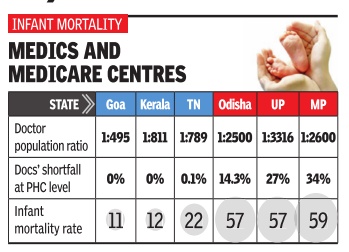
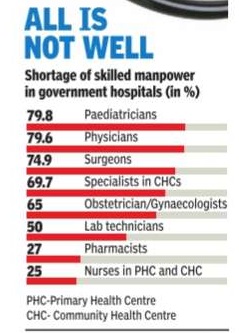
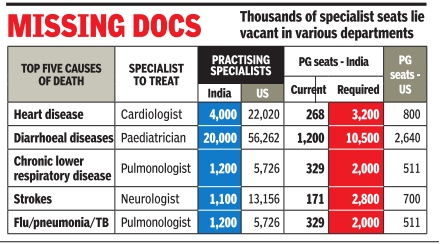
This is a collection of articles archived for the excellence of their content.
|
Contents |
Government facilities inadequate; private expensive
Where State Drives Patients To Private Wards
Rema Nagarajan
The Times of India Sep 19 2014
A shortage of doctors and hospitals
An expensive private sector has stepped in where govts failed -delivering health facilities that are often suspect. The trend grows while state facilities struggle to cope
Public health infrastructure is wanting by even government's own assessments. This is true of subcentres at the lowest rung to community health centres (CHCs) and district hospitals. There's a shortage of about 7,000 primary health centres (PHCs). In some states, the shortages are staggering -66% in Jharkhand, 58% in Bengal and 42% in MP . Only two-thirds of the required number of CHCs are in place.In Bihar, against a need of 774 CHCs there are just 70, a 91% shortfall. Assam has less than half of what it needs, UP 40% less.
There's an even bigger crisis of health personnel: A shortfall of 2,225 doctors in PHCs, and the gap's growing bigger. Over 36% PHCs were without a lab technician, 23% without a pharmacist. There is a 53% shortfall in radiographers. Considering just the existing infrastructure, there was a shortfall of all kinds of specialists including 72.2% of surgeons, 64.7% of obstetricians and gynaecologists, 82.1% of physicians and 73% of paediatricians. In effect, even in the existing infrastructure isn't staffed. In many states, health indicators of the urban poor are far worse than their rural counterparts, revealing how underserved the urban poor are. In the mostlyurban Delhi, there's massive shortage of subcentres, PHCs and CHCs.
The bulk of healthcare in India is provided by the private sector, that's meant escalating costs. In states like Rajasthan and Tamil Nadu, governments demonstrated how providing free drugs and diagnostics in public facilities could significantly bring down health expenditure. Yet, neither the Centre nor other states replicated these programmes. In the name of universal healthcare, government is being persuaded to become the payer for healthcare provisioned by the private health sector and administered by insurance companies. In most states, these insurance programmes have been riddled with corruption and inefficiencies such as the epidemic of hysterectomies done on hundreds of women by hospitals in Andhra to collect government money for the procedure. There's concern among health activists that state funds that could be used to strengthen public health infrastructure are getting diverted to the private sector.
Government funds
In absolute terms, the money allocated for health by government has gone up more than 13 times from Rs 2,000 crore in 2000-01 to Rs 27,500 crore-plus in 2013-14. Yet, health expenditure is short of 1.5% of GDP though successive governments have promised that spending would touch 3%. If the promised 3% had been allotted, perhaps the public health sector could have been revolutionized to deliver quality service.
Government expenditure on health: 2012
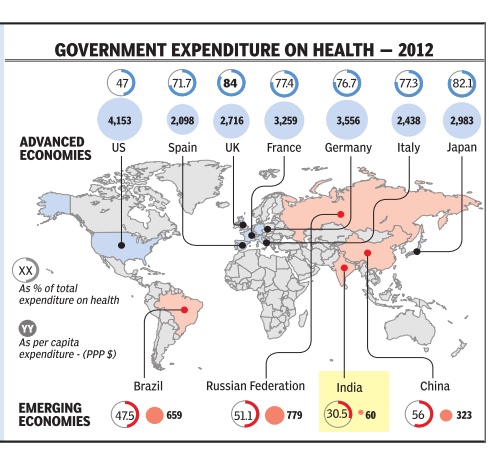
May 25 2015
When it comes to government expenditure on health, India's is among the lowest in the world. In 2012, at 60 PPP* dollars per capita, it was barely 1.4% of the US government's per capita health $ expenditure of 4,153 PPP dollars.Despite having such a high per capita public expenditure on health, the extremely high cost healthcare system in the US means the government covers only 47% of total healthcare costs. In the UK and Japan, more than 80% of the cost is covered by government. In India, government expenditure is only 30.5% of total expenditure on health *purchasing power parity Source: WHO; Research: Atul Thakur; Graphic: Sunil Singh
Availability of doctors: India
`More docs, not health centres, save lives'
Himanshi.Dhawan @timesgroup.com New Delhi
The Times of India Aug 19 2014
Higher No. Of Medics Help Check Crib Deaths: Study
Do hospitals translate to better healthcare? Not necessarily . States with more doctors have better healthcare indices than those with better infrastructure, data analysed by thinktank Swaniti reveals.
While better health outcomes depend on multiple reasons, it appears that doctor to population ratio had a far higher impact on infant mortality rate (IMR) or maternal mortality rate (MMR) than better infrastructure.Tamil Nadu that has fewer primary health centers (PHCs), one per lakh of population, as compared to Chhattisgarh and Odisha that have two PHCs is better placed in health outcomes.
Tamil Nadu has one doctor for 789 patients and an infant mortality rate of 21 and maternal mortality of 97.
In sharp comparison, Chhattisgarh has one doctor for 6,221 patients and witnesses 47 infant deaths for every 1,000 live births and 269 maternal deaths per 1,00,000 live births. Odisha that has one doctor for 2,500 patients, too, suffers from high infant and mother deaths. It has IMR of 53 and MMR of 258, respectively.
Interestingly , states like Andhra Pradesh, Goa, Karnataka, Kerala and Tamil Nadu alone account for 42% of all medical colleges in India thereby producing most of India's doctors. Not surprisingly , these states also have the best Doctor Population Ratio (DPR).
These states show no shortfall of doctors at PHC level and have already met the Millennium Development Goals (MDG). At least three of the five -Kerala, Goa and Tamil Nadu -have IMR below 21. Incidentally , West Bengal has one of the highest per capita coverage of primary health centres -nine per lakh population.However, it has just one doctor for 1,508 patients and IMR of 32 while its MMR is 145.
In comparison, north Indian states of Madhya Pradesh, Bihar, Uttar Pradesh, Odisha and Chhattisgarh have very few medical colleges, a fact which reflects in their DPR.
Unsurprisingly , most states with poor DPR also had a relatively high shortfall of doctors at the PHC lev el. For example a state like Bihar has one doctor for every 2,785 people. This translates to IMR of 43 and a MMR of 261.
When these numbers are viewed against the MDG target of 27 for Infant Mortality Rate in India by 2015, it becomes clear that these states need to act urgently to improve their performance in public health.
“It is important to go beyond merely having doctors and invest in improving the quality of healthcare professionals in India. National Healthcare Policy , another promise by the new government, should hopefully lead to greater public investment in healthcare, and improve the quantity and quality of healthcare in India while reducing regional disparities.
Some of the other factors are efficient utilization of funds, good quality of human resources in healthcare, and finally awareness among people. Rwitwika Bhattacharya from Swaniti said.
Dengue
Alarming 80% rise in dengue cases in 2013
Durgesh Nandan Jha TNN
The Times of India 2013/08/21
New Delhi: Dengue cases have risen alarmingly across the country this year, with data showing an 80% rise in the disease till July 31 as compared to the same period last year.
India has recorded 15,983 dengue cases so far in 2013 as compared to 8,899 cases in the corresponding months last year, latest health ministry data shows. But the good news is, while the cases have risen sharply, fatalities have actually declined — 56 as compared to 76 last year.
Kerala reported most dengue cases at 5,801, followed by Karnataka (3,775), Tamil Nadu (3079) and Maharashtra (961) till end-July. Delhi witnessed a sharp rise in cases over the last few weeks, with the total this year touching 54. No one has died due to dengue in the capital so far.
‘Several factors for spread of dengue’
“There is no single reason for the increase in dengue cases. It is governed by various man-made and environmental factors including unprecedented growth in population, unplanned and rapid urbanization and inadequate waste management,” union health minister Ghulam Nabi Azad stated in a written reply in the Lok Sabha on Tuesday.
Increasing mobility of the population and poor infrastructure to monitor mosquito breeding were some other reasons cited by the health minister. Azad said guidelines for clinical management of dengue cases have been sent to the states for circulation in hospitals and rapid response teams have been formed.
Dengue, termed by many experts as the world’s most rapidly spreading mosquito-borne viral disease, is caused by four serotypes. While type I and III are milder in nature causing classic dengue fever and fever without shock, respectively, dengue type II and IV are considered deadly. These cause fever, bleeding and a drop in platelet count. Researchers say severe dengue cases, dengue hemorrhagic fever and dengue shock syndrome, started showing up in India since 1988.
“A reason behind the increased frequency could be the presence of many strains of the virus. It exposes people already infected to become susceptible to infection as they are not immune to all the subtypes,” said Dr Ekta Gupta, clinical virologist at the Institute of Liver and Biliary Sciences (ILBS).
Experts say construction sites are a major area of mosquito-breeding followed by government buildings and water tanks. “In Mumbai, the municipal body, charges heavy fines if mosquitoes are found to be breeding at a site. The building’s completion certificate is stalled till the fine is paid. Similar steps should be taken in cities like Delhi,” said Dr Jagdish Prasad, director general of health services.
Better healthcare still out of bounds
New Delhi: India may be among the fastest growing economies in the world, but the UNDP’s Human Development Report 2006 shows that this growth hasn’t translated into better public healthcare for the citizen, at least not as yet. For instance, there are only seven countries — of the 177 that the HDR looks at — with a lower share of public expenditure in total health expenditure. These seven — Guinea, Congo, Myanmar, Cambodia, Armenia, Tazikistan and Burundi — are not exactly those with whom India would like to be compared, but they are the only ones in which the government accounts for less than a quarter of total health expenditure. For India, the share of public expenditure in the total is exactly one-fourth or 25%.
The low share of public health expenditure is not surprising, given the fact that only 13 countries spend a smaller proportion of the gross domestic product (GDP) on the health sector than India’s level of 1.2%. Apart from six of the seven mentioned above, these include Pakistan and Bangladesh in our neighbourhood as well as Azerbaijan, Georgia, Ivory Coast, Equatorial Guinea and Indonesia. One result of this low level of government spending on healthcare is that people have to spend more from their pockets to keep themselves in good health. Thus, India’s private spending on healthcare at 3.6% of GDP is higher than most. In fact, only 33 of the remaining 176 countries has a higher level on this count.
However, the high private expenditures are clearly unable to bridge the gap when it comes to things like immunisation, which are typically public programmes in most parts of the globe. Not surprisingly, India’s immunisation rate for those who are one-year old against measles is worst in the world, with just 13 countries doing worse. A similar picture emerges if we look at the numbers for full immunisation of one-year olds against tuberculosis. Again, there are a mere 20 of the 176 others who have a lower rate.
What highlights all of this as a glaring failure of our governments is the fact that India’s pool of roughly 6.5 lakh physicians is the third biggest in the world after China, which has about twice as many, and the US, which has only a few tens of thousands of doctors more than India, although for a population that’s only about onethirds the size of India’s.
Breastfeeding
Only 44% newborns get mother’s milk

The Times of India, Sep 2, 2015
Himanshi Dhawan
Less than 50% are breastfed in first hour of birth in India
Despite increase in institutional deliveries, the number of children in India being breastfed in the first hour of birth is less than half.
India in fact ranks lowest among South Asian countries, including Afghanistan, Bangladesh and Sri Lanka in breastfeeding practices, with only 44% women being able to breastfeed their babies within one hour of delivery.
According to the World Breastfeeding Trends Initiative (WBTi) 2015, India scored 78 out of 150, only marginally higher than its 2012 score of 74. Paucity of data, ineffective policies, lack of budget and coordination, and absence of better monitoring are limiting breastfeeding practices in India.
Prepared by the Breastfeeding Promotion Network of India (BPNI) and the Public Health Resource Network (PHRN), the report indicates marginal improvement in Infant and Young Child Feeding (IYCF) practices. "It is not understandable why only 44% of women are able to begin breastfeeding within an hour when more than 75% of women deliver in institutions as claimed by PM Modi," Arun Gupta, BPNI central coordinator said. The report recommends an effective monitoring mechanism, national policy on IYCF, revival of baby-friendly hospitals, maternity protection and provision of a nine month maternity leave. The assessment, done every three to five years as part of WHO's World Breastfeeding Trends Initiative (WBTi), reveals gaps in all ten areas of policies and programmes to be implemented for enhancing breastfeeding rates.
According to the data, out of 26 million born in India, 14.5 million children are not able to get optimal feeding practices during the first year of life. While 44.6% women initiate breastfeeding within one hour of delivery, 64.9% are breastfed up to six months and 50.5% babies receive complementary food within 6-8 months.
The report said increasing sale of infant food, lack of support to women in the family and at workplaces and inadequate healthcare support as reasons behind low breastfeeding rate in the country.
Doctors, in rural areas
Funds fail to draw docs to villages
Despite 42,000cr Kept Aside For Rural Medical Care, Rs 10,000cr Lying Unspent Subodh Varma TIMES INSIGHT GROUP
As the country awaits another central government Budget, there is a growing demand for more financial muscle on several fronts. But, is throwing money at complex problems really a solution? A look at the progress of a crucial program of the government, the National Rural Health Mission (NRHM), indicates that money can’t buy everything.
One of the biggest bottlenecks facing policy-makers is that of medical personnel. Recently released data by the ministry of health and family welfare shows a shocking shortfall of doctors, nurses, health assistants, radiographers, pharmacists and other personnel in the rural health delivery structure. This is despite over 82,000 new personnel being appointed under NRHM in the past four years and many villages getting to see a doctor for the first time.
The situation is worse for qualified doctors. Just 20% of required pediatricians and only about 26% of surgeons, obstetricians and gynaecologists, and general physicians are in place. They are needed at the Community Health Centres (CHC), each serving a population of 1.2 lakh. Among technical personnel, only about 40% of the required radiographers and 47% of laboratory technicians are in place to run diagnostic labs. There is a shortfall of about 25% for pharmacists, and 16% for staff nurses.
Even at the lower rungs of the medical service hierarchy, like the health sub-centres and primary health centers, many of the key personnel are not yet appointed. Nearly a quarter of 46,000 male and female health assistants are missing, while over 60% of health workers are not yet in place. The situation is much better for the auxiliary nurse and midwife (ANM) with about 90% appointments having taken place, but that still leaves nearly 16,000 ANM posts vacant. Two ANMs are required at the primary level in order that delivery cases are handled day and night. Just about one third of the PHCs are functioning with two ANMs.
Expenditure data shows that the problem is not of resources. Out of the Rs 42,000 crores released by the central government in the past four years for NRHM, nearly Rs 10,000 crore is lying unspent with state governments. In addition, all state governments together have allocated an eyepopping Rs 1,06,388 crore for health and family welfare in their respective states.
Yet, progress under NRHM, has been uneven, and the country is still far from achieving goals set for various health indicators. “Spending money jazzing up an auto-rickshaw is not going to convert it into a car”, says public health expert Dr Amit Sengupta. A thorough revamp of the infrastructure is needed and the government needs to think afresh about it, he says.
But why are medical personnel not in place? “An indifferent political leadership and bureaucracy, deficient medical education infrastructure, especially for technical and paramedical staff, low salaries for doctors, and frustration among them in rural postings as there are no drugs, no support staff and erratic infrastructure, are some of the problems,” Sengupta said. “Sadly, doctors prefer lucrative private incomes in urban areas or foreign lands, rather than serving people in the villages,” he says.
Use of allopathy, on a rise
The Times of India, Jul 08 2015
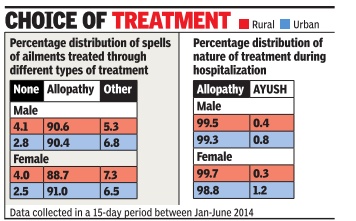
Mahendra Singh
90% of Indians prefer allopathy over AYUSH
Alternative medicines more popular with urban men
Despite the government's attempt over the years to popularize AYUSH (ayurveda, yoga or naturopathy , unani, siddha and homoeopathy), the people at large are still inclined towards allopathy treatment both in rural and urban India. The NSSO survey has found higher inclination towards allopathy treatment-around 90%-in both rural and urban areas. Only 5 to 7% usage of `other' type of treatment including AYUSH has been reported both in rural and urban areas.
Interestingly , a higher usage (1.5 percentage point) of AYUSH treatment by urban males than their rural counterparts was noted, while less usage of the same (0.8 percentage point) by urban females as compared to rural females was observed.
The use of allopathy was also most prevalent in treating the hospitalized cases of ailments both in rural and urban settings of the country irrespective of gender. Surprisingly , use of AYUSH for hospitalized treatment in urban areas (0.8% for male and 1.2% for female) was more than rural areas (0.4% for male and 0.3% for female).
Moreover, un-treated spell was higher in rural (both for male and female) than urban.
The relationship between the percentages of untreated spells of ailments and level of living was also revealed. Untreated spell was less in those with usually higher monthly per capital expenditure for both rural and urban sector.
The survey found that private doctors were the most important single source of treatment in both rural and urban areas. More than 70% (72% in rural areas and 79% in urban areas) spells of ailment were treated in the private sector, consisting of private doctors, nursing homes, private hospitals and charitable institutions. The number of people reporting sick is more in urban India compared to rural areas, found the survey.
Suicides due to illness
One in 5 suicides in India due to illness
Ekatha Ann The Times of India Nov 05 2014
Chennai:
2013: 26,426 People Suffering From Various Ailments Chose To End Their Life
Shame and pain caused by an ailment was the reason for one in every five suicides in India last year.
Data compiled by the National Crime Records Bureau show 26,426 people in the country suffering from various ailments, including cancer, AIDS and paralysis, chose to end their lives last year. Tamil Nadu had the highest number of suicides linked to illness in 2013, with 4,362 people taking the extreme step. o “After family problems, termi nal illness is one of the biggest reaa sons for people to take the extreme l step,“ said P V Sankaranaraya e nan, a counsellor at suicide pret, vention organization SNEHA, l which also operates a helpline. He w said most of the calls they receive f are from those who are bedridden s, or in pain. “They feel guilty for bea ing a burden on their families.
Some are lonely and frustrated.
They think no one understands k their pain,“ he said, adding that 2 the number of such suicides could be higher as families tend to cover it up as natural death.
After prolonged illness, “insanity“ was the second reason that pushed people to the edge, constituting 30% of suicides linked to ailments. “There are studies showing the link between mental health and suicide. A physical ailment only pushes the person further to the brink. Unfortunately , secondary depression because of an illness is often ignored,“ said Dr R Padmavati of Schizophrenia Research Foundation.
The number of people with cancer committing suicide has seen a significant jump, with Kerala taking the lead with 155 such cases. Dr C S Mani of Cancer Research and Relief Trust said patients who come to him feel “setbacks“ at multiple levels: during diagnosis, when they have a relapse and when they are recommended palliative care. “There comes a point when there's no treatment available to cure the patient as the chemotherapy and the medication have proved ineffective. That's when we treat just the symptoms and wait for the disease to take over. Sometimes death is quick, at times it is long and painful,“ said Dr Mani. “For many , it is the fear of pain that takes over,“ he said, adding that suicidal tendencies usually creep in at this stage.
Dr N Kathiresan, an oncologist at the Cancer Institute, Adyar, said many patients preferred death over amputation. “We show them examples of people who have reached heights despite not having a limb. Often it works, sometimes it doesn't,“ he said. He recalled a recent case of a boy from Bihar who had to get his leg amputated. “He didn't respond to the chemotherapy . When we told the family we would have to amputate his leg, the family refused to comply . We tried advising them. The disease soon took over,“ he said.
Experts say besides giving importance to palliative care, hospitals could have more counsellors. “Doctors must also be trained to handle patients sensitively and pick up signs of depression. The mental and emotional health of a patient is often ignored. This has to change,“ said Dr Padmavati.

Immunisation and literacy

Please see
Healthcare: India Healthcare: Delhi Healthcare: Tamil Nadu
